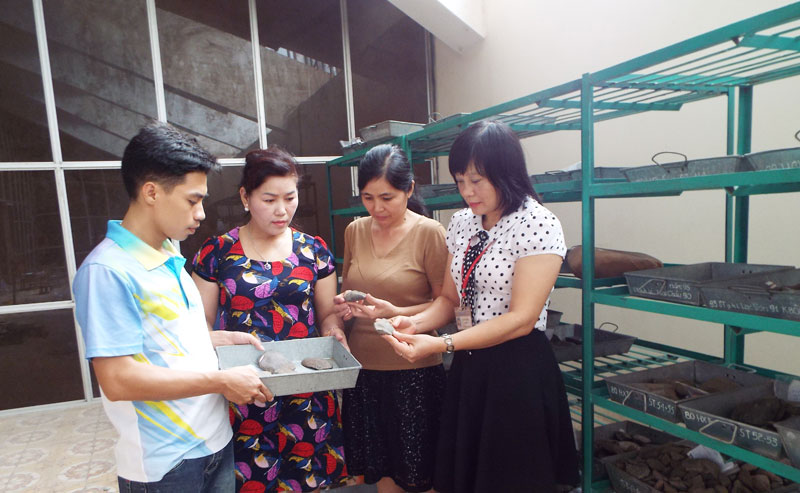
(HBO)- On the occasion of the 85th anniversary of the world recognition of the "Hoa Binh Culture”, Hoa Binh province will organise numerous activities to popularise and honour the unique archaeological values of the world-renowned Stone Age culture in the province. Hoa Binh Online reporters had a talk with Buil Ngoc Lam, Director of the provincial Department of Culture, Sports and Tourism and head of the organising board for commemoration activities.

Provincial museum staff arrange artefacts for an exhibition on the
occasion of the 85th anniversary of world recognition of "Hoa Binh
Culture”
Reporter: Could you give a general introduction about the "Hoa Binh
Culture”?
Mr. Bui Ngoc Lam: The term "Hoa Binh Culture” is used with two
meanings, one of which is the culture of all ethnic groups in Hoa Binh, and the
other is the archaeological culture.
Here we are talking
about the archaeological culture which dates back to the Stone Age, from
3,500-7,000 years ago.
The Hoa Binh Culture
was first discovered and studied by French woman archaeologist Madeleine Colani
in the years from 1926-1931. She also coined the term Hoa Binh Culture. In
1932, at the first conference on the prehistory in the Far East held in Hanoi,
world archaeologists agreed to adopt this term.
However, the Hoa Binh
Culture existed not only in Vietnam. In fact, it covered a large area in
Southeast Asia, but Vietnam was the place with the most relics of the culture,
so many foreign scientists considered the country as the birthplace of Hoa Binh
Culture. In Vietnam, Hoa Binh province is the place where the first relic of
Hoa Binh Culture was found, and it is also home to the most relics discovered
so far, that is why the province’s name was used to call the culture.
Reporter: On the 85th anniversary of world recognition of "Hoa Binh
Culture”, the province will organise many commemorative activities. Could you
please tell us about the meaning and significance of the anniversary?
Mr. Bui Ngoc Lam: Among commemorative events there will be an
exhibition on the Hoa Binh Culture, which will last through December. The
provincial library will host a display of books on the Hoa Binh archaeological
culture and the cultures of ethnic groups in Hoa Binh province. At the
provincial cultural palace, there will be a display of photos selected during
the Hoa Binh tourism photo contest in
2017. A scientific seminar on Hoa Binh Culture
will also be held here, along with an art performance and a demonstration of Mo
Muong.
Activities to celebrate
the 85th anniversary of world recognition of "Hoa Binh Culture” are
intended to popularise and honour the unique archaeological values of the
world-renowned Stone Age culture in Hoa Binh; honour the great contributions of
the French archaeologist Madeleine Colani who discovered and named the culture.
The activities also aim to foster the pride about the ethnic groups in the
province – the cradle of the Hoa Binh Culture and one of the cradles of human
kinds’ civilisation, and teach young generations about the local traditions.
Reporter: Thank you very much.
The People’s Committee of Lac Son district held a ceremony on April 28 to receive the provincial relic certificate for the ancient rock carving site at Suoi Co stream, located in My Thanh commune.
A special music show titled "The country is in the fullness of joy” has been held at Hoa Binh Square in Hoa Binh city in celebration of the 50th anniversary of the liberation of the South and national reunification (April 30, 1975–2025).
The People's Committee of Lo Son commune, Tan Lac district, has organised the local annual traditional stream fishing festival on April 19 - 20.
As a land deeply intertwined with human history and Vietnam’s millennia-long journey of nation-building and defence, Hoa Binh is often revered for its epic tales and legends.
Residents of Hoa Binh boast a rich cultural identity, reflected in their unique language, traditional attire, customs, and folk melodies – described as "sweet as honey, clear as a mountain stream.”
Lac Son district’s Vu ban town held the 2025 Truong Kha temple festival on April 12–13 (the 15th–16th days of the third lunar month). Since its revival in 2019, the festival has been organised every three years, preserving valuable intangible heritage while meeting the community’s cultural and spiritual needs.



